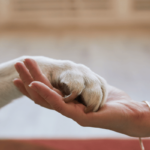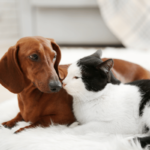Explore the fascinating world of feline communication in ‘Understanding Cat Meows: Decoding Feline Chatter,’ a deep dive into what your cat’s meows really mean.
The Language of Cat Meows
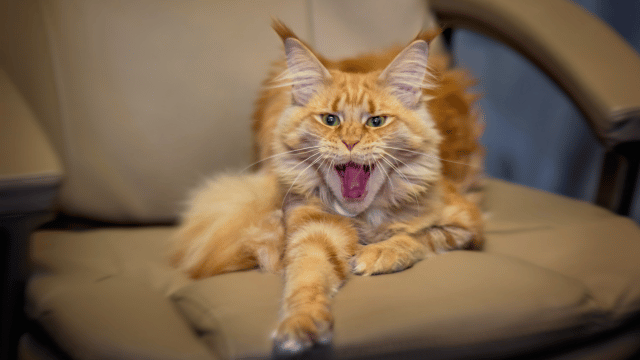
Different Types of Cat Meows: Cats communicate through various meows, each carrying a unique message. High-pitched, insistent meows often signal a demand for attention, accompanied by actions like pawing. In contrast, low-pitched, angry meows, mixed with hissing, indicate displeasure or threat. Understanding these meows allows owners to respond appropriately, nurturing a deeper bond with their pets.
Interpreting the Subtleties of Meows: The tone, pitch, and volume of a cat’s meow can reveal their feelings and needs. A loud meow might show urgency or a call for attention, while a softer one often signifies contentment. High-pitched meows could express excitement, and longer meows might indicate distress. Observing these nuances helps cat owners decipher their cat’s needs, ensuring better care and stronger emotional connections.
Responding to Your Cat’s Vocalizations: Responding correctly to cat meows fosters positive behavior. Reward desirable meows, like friendly greetings, with attention or treats. Conversely, ignore excessive or night-time meows to discourage these behaviors. Offering play and mental stimulation can prevent boredom, decreasing the likelihood of excessive meowing. By attentively responding to their meows, owners can ensure a harmonious relationship with their feline companions.
10 Curiosities or Tips:
- Attention-seeking meows are high-pitched and often involve physical gestures for affection.
- Greeting meows are soft, chirpy sounds expressing happiness upon seeing their owner.
- Angry meows are low-pitched, signaling upset or defensive behavior.
- Fearful meows are high-pitched, indicating anxiety or distress.
- The volume of a meow can show the urgency of a cat’s message.
- Different meow pitches may convey excitement, playfulness, frustration, or discomfort.
- Short meows might express immediate needs, while longer ones can signify discomfort.
- Positive reinforcement for good meowing behavior encourages repetition.
- Ignoring unwanted meows reduces negative behavior reinforcement.
- Excessive meowing can be a sign of health issues like hyperthyroidism or cognitive dysfunction.
Nuances in Feline Vocalization
Health Concerns Indicated by Cat Meows: Excessive or altered meowing can be a red flag for health issues in cats. For instance, constant loud meowing might indicate hyperthyroidism, while changes in meow patterns could suggest oral pain or hearing loss. These signs should prompt a visit to the vet. Understanding these health-related vocal cues is crucial for early intervention and ensuring the wellbeing of our feline friends.
Age-Related Changes in Cat Meows: As cats age, their meowing behavior may change. Older cats often become more vocal, potentially due to age-related dementia or deteriorating eyesight, leading to confusion and increased vocalization. Awareness of these age-related changes helps in providing appropriate care, including veterinary check-ups to ensure any medical issues are promptly addressed, thereby maintaining the quality of life for aging cats.
Cats’ Meows and Breed-Specific Tendencies: Some cat breeds are naturally more vocal than others. For instance, Siamese and Abyssinian cats are known for their talkative nature. Recognizing breed-specific vocal tendencies helps owners better understand and meet their cat’s communication needs. Familiarity with these breed traits can enhance the cat-owner bond, enabling a more harmonious and understanding relationship between the two.
Emotional Expressions Through Meows
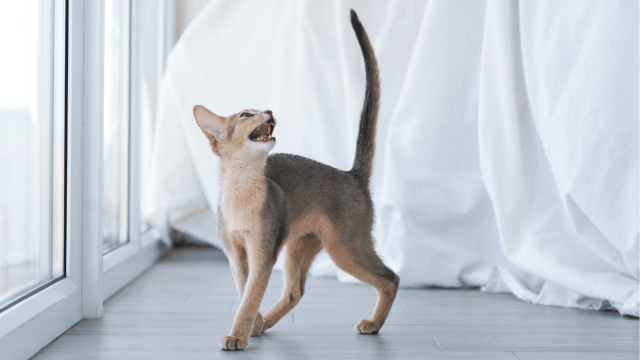
Communicating Comfort and Distress: Cats use meows as tools for expressing both comfort and distress. Contentment is often signaled through soft, gentle meows, especially when accompanied by purring. Conversely, distress or discomfort is conveyed through louder, more persistent meows. Owners attuned to these subtle differences can more effectively discern their cat’s emotional state, enabling timely and empathetic responses to their pet’s needs, thereby nurturing a trusting and responsive bond.
Interactions Among Cats: Vocal and Silent Communication: Interestingly, adult cats primarily meow at humans, not other cats. Cat-to-cat communication typically involves silent body language, hissing, or growling. This behavior highlights cats’ sophisticated and adaptable communication skills, where they have developed distinct ways to interact with humans versus their own species. Understanding this aspect of feline behavior helps owners appreciate the uniqueness of their cat’s vocalizations as a tailored form of human interaction.
The Evolution of a Kitten’s Meow: Kittens meow frequently as a primary form of communication with their mother, often signaling hunger or cold. As they grow, their reliance on meowing decreases, turning to other forms of communication. This transition from vocal dependency to independence in kittens reflects their developmental journey. Owners observing these changes can better support their kitten’s growth into a confident and well-adjusted adult cat.
Cats’ Vocalizations as Behavioral Indicators
Understanding Meows as Behavioral Cues: Cats often use meows to express a variety of behaviors. For instance, meowing can be a tool for manipulating their environment, such as requesting food or access to a room. It’s essential to recognize these cues and respond appropriately to maintain a balanced interaction. Ignoring certain meows, especially those for basic needs, can lead to stress or behavioral issues in cats.
The Impact of Human Interaction on Cat Meows: Humans play a significant role in shaping a cat’s meowing behavior. Cats that enjoy frequent and positive interaction with humans tend to be more vocal. This is especially true for kittens that are handled often and socialized well. Understanding this correlation helps cat owners in fostering an environment where their cats feel comfortable expressing themselves, strengthening the bond between pet and owner.
Cats’ Vocalization in Multicat Households: In multicat households, the dynamics of meowing can change. Cats may develop unique ways of communicating with each other and their human family members. Owners should observe interactions to understand each cat’s vocal language within the household. This observation aids in identifying any signs of distress or discomfort, ensuring a harmonious living environment for all pets.
The Role of Breed in Cat Vocalization
Breed-Specific Vocal Traits in Cats: Certain cat breeds are known for their distinct vocal traits. Breeds like the Siamese or Maine Coon are naturally more vocal and expressive with their meows. Owners of these breeds should anticipate and appreciate this trait, understanding it as a part of their breed’s identity. This knowledge aids in providing breed-specific care, ensuring that the cat’s communicative needs are met adequately.
Adapting to Your Cat’s Vocal Behavior: Every cat is unique, and their vocal behavior can vary widely. Some cats may be naturally quiet, while others are more vocal. Owners should adapt to their individual cat’s level of vocalization, providing an environment that respects and responds to their specific communication style. This adaptive approach ensures that all cats, regardless of their vocal tendencies, feel understood and comfortable in their homes.
The Influence of Environment on Cat Vocalization: A cat’s environment can significantly influence its vocal behavior. Cats in a stimulating, interactive environment may be more vocal, expressing their curiosity or excitement. On the other hand, a more subdued environment might lead to less vocalization. Owners should create a living space that encourages healthy and natural vocal expressions, catering to their cat’s personality and comfort.
Feline Vocalization in Different Settings
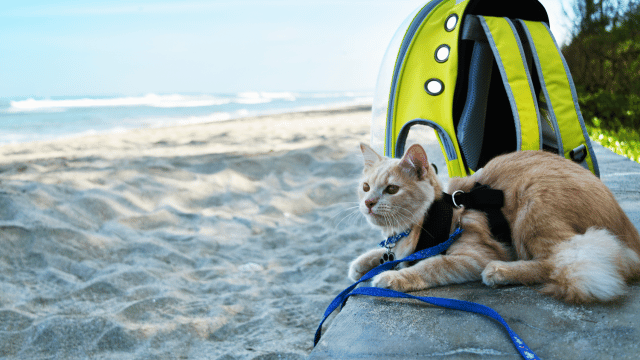
Vocalization in Indoor vs. Outdoor Cats: Indoor and outdoor environments can influence a cat’s vocal habits. Indoor cats, often relying more on human interaction, might develop a wider range of meows to communicate with their owners. Outdoor cats, on the other hand, might use meows less frequently, relying more on body language for communication in the wild. Understanding this difference helps owners provide a suitable environment that stimulates natural vocal behavior in their cats.
Adaptation of Cat Meows in New Environments: When introduced to new environments, cats may alter their vocal patterns. Initially, a cat may be quieter, observing and adapting to their new surroundings. Gradually, as they become comfortable, their true vocal nature may emerge. Owners should provide a supportive and stress-free environment to help their cats adjust smoothly, understanding that this adaptation period is a normal part of their cat’s acclimation process.
Cat Vocalization as a Reflection of Health: A sudden change in a cat’s vocalization can be an indicator of health issues. A cat that becomes unusually vocal or silent may be experiencing discomfort or illness. Such behavioral changes warrant a veterinary consultation to rule out any underlying medical conditions. Regular health check-ups and attentive observation of vocal changes play a critical role in maintaining a cat’s health and wellbeing.
Enhancing Human-Cat Communication Through Understanding Meows
Strengthening Bonds Through Vocal Understanding: Understanding the nuances of a cat’s meows can significantly strengthen the bond between cat and owner. Responding appropriately to different meows reinforces positive communication, enhancing mutual trust and affection. Owners who are attentive to their cat’s vocal cues can create a deeper, more empathetic relationship, fostering a sense of security and understanding for their feline companion.
Training and Behavioral Aspects of Cat Vocalization: Training can influence a cat’s meowing behavior. Positive reinforcement techniques can encourage desirable vocalizations, while discouraging excessive or disruptive meowing. Understanding the motivations behind a cat’s meows can also aid in addressing behavioral issues, allowing for more effective training and communication strategies. It’s crucial to approach training with patience and consistency, adapting to the cat’s individual communication style.
The Future of Feline Vocal Research: As research into feline vocalization continues, new insights will likely emerge, further enhancing our understanding of cat communication. Future studies may reveal more about the emotional complexities behind meows and how cats use vocalizations to interact with humans and other animals. Such knowledge promises to deepen the human-cat relationship, offering more ways to connect with and care for our feline friends.
Concluding Paragraphs:
Embracing the Language of Cats: In conclusion, understanding cat meows is more than deciphering sounds; it’s about embracing a language unique to our feline friends. Each meow, chirp, or purr is a window into a cat’s mind and emotions. As cat lovers and owners, embracing this language not only enhances our interaction with cats but also elevates our responsibility to respond with empathy and understanding.
The Joy of Feline Companionship: The joy of feline companionship is enriched when we understand our cats’ vocal expressions. It transforms ordinary interactions into meaningful conversations, fostering a harmonious living environment. As we grow in our understanding of cat meows, we become better caregivers and friends to our cats, celebrating the unique bond that forms the heart of every cat-owner relationship.
A Continued Journey of Discovery: The journey of understanding cat meows is ongoing, filled with discoveries and surprises. Each cat’s voice is a blend of mystery and familiarity, an invitation to continual learning and connection. As we keep exploring this fascinating aspect of feline behavior, our appreciation for the intricate world of cats deepens, promising a rewarding and loving companionship for years to come.
Read more: How To Communicate With Your Cats: Talking & Understanding Your Pet
II. Frequently Asked Questions About Dog and Cat Behavior
- How do cats and dogs behave differently?Cats and dogs exhibit distinct behaviors due to their evolutionary backgrounds. Dogs, being pack animals, are generally more social and eager to please, often seeking attention and approval from their owners. Cats, on the other hand, are more independent and territorial, showing affection on their terms.
- How do dogs act with cats?Dogs may act curiously or playfully with cats, especially if socialized properly. However, their behavior can vary widely based on the dog's breed, temperament, and previous experiences with cats.
- Will a cat and a dog get along?Yes, a cat and a dog can get along with proper introductions and training. Their relationship often depends on their individual personalities and the way they are introduced to each other.
- Why does my dog have cat behavior?Some dogs may exhibit behaviors typically associated with cats, such as grooming themselves or being more solitary, which could be due to individual personality, breed traits, or environmental influences.
- What is a pet behaviorist?A pet behaviorist is a professional who specializes in understanding and modifying animal behavior through various techniques, often addressing issues like aggression, fear, or anxiety in pets.
- Are animal behaviorists worth it?Yes, animal behaviorists can be incredibly valuable, especially for addressing complex behavioral issues, improving pet-owner relationships, and ensuring the well-being of the pet.
- What is a behavioral vet?A behavioral vet, or veterinary behaviorist, is a veterinarian who specializes in diagnosing and treating behavioral issues in animals, combining medical and behavioral science.
- What is a cat behavior consultant?A cat behavior consultant specializes in understanding and addressing behavioral issues in cats, offering tailored advice to resolve problems like aggression, litter box issues, or excessive meowing.
- How do I train my dog to behave around cats?Training a dog to behave around cats involves gradual introductions, positive reinforcement for calm behavior, and setting clear boundaries to ensure safe interactions.
- Can I train my dog and cat to get along?Yes, with patience and consistent training, you can encourage positive interactions and mutual respect between your dog and cat, fostering a peaceful coexistence.

Join Dan Morgan at dwfocus.com, your hub for ‘4 paws and owners’ wisdom! Explore a world where pet care meets expert insights, crafted by Dan, a seasoned vet with a heart for animals. Engage with stories, tips, and advice that every pet owner needs. From playful pups to graceful cats, Dan Morgan guides you through the joys and challenges of pet parenting. Embrace your love for pets with Dan’s expert guidance on dwfocus.com. #4PawsAndOwners #DanMorganPetExpert #dwfocus





